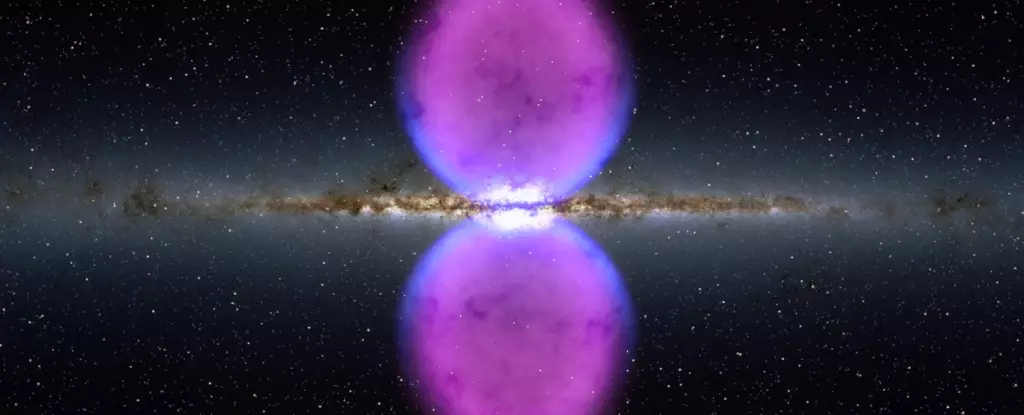In the relentless inferno of the Fermi Bubbles—a pair of colossal, energetic lobes towering above and below our galaxy—scientists have made a discovery that defies conventional wisdom about galactic phenomena. For decades, the narrative has been that such extreme regions, characterized by temperatures reaching a staggering one million Kelvin, are inhospitable to any form of cold, neutral matter. Yet, recent observations reveal a paradoxical truth: the existence of eleven relatively cool hydrogen clouds thriving amid the chaos, akin to stumbling upon ice cubes nestled within a volcanic eruption. This groundbreaking find challenges the very foundation of our understanding of galactic physics and compels a re-examination of longstanding assumptions.
Rather than being isolated anomalies, these clouds demonstrate that even within the universe’s most violent arenas, pockets of serenity and coldness can persist. Their survival in an environment of blistering plasma suggests a resilience that was previously unimagined. This discovery compels astrophysicists to rethink how cold gas phases endure and interact with energetic outflows, suggesting that molecular and neutral hydrogen can survive—and perhaps even thrive—in conditions once thought to be purely hostile.
Rethinking Galactic Outflows and Recycling: The Significance of Cold Gas in a Hot Universe
The presence of these cold hydrogen clouds in the Fermi Bubbles is more than an anomalous curiosity; it is a paradigm shift in the narrative of galaxy evolution. Traditionally, astronomers have viewed galactic outflows—massive winds expelled by supermassive black holes and starburst activity—as primarily hot, energetic phenomena that sweep away cold gas, quenching star formation and dictating the lifecycle of galaxies. Yet, these findings suggest a more nuanced picture, where cold gas not only survives but may also be integral to the cycling of matter.
The fact that these clouds are relatively young—estimated to be only a few million years old—points to their recent entrainment in the nuclear wind emanating from the galaxy’s core. These clouds seem to act as tracers, providing a tangible window into the otherwise invisible force of the outflows. As explained by researchers, this is analogous to observing atmospheric clouds to measure wind patterns—except here, the clouds reveal the movement of the galaxy’s invisible nuclear wind. This insight could revolutionize how we interpret the feedback processes that regulate star formation and galaxy growth across cosmic timescales.
Furthermore, the existence of such clouds hints at a complex interplay of forces, with thermal instabilities possibly causing the clouds to condense from warmer plasma, or alternatively, fragments breaking off from larger structures. These processes underscore a universe that is far more dynamic and turbulent than previously appreciated, where matter constantly shifts between phases, defying simplistic models of galactic evolution.
Challenging Assumptions: The Age and Origin of the Hydrogen Clouds
Quantifying the age and origin of these hydrogen clouds is key to understanding their role in the galactic ecosystem. The research suggests these clouds are only a few million years old, significantly younger than some models of the Fermi Bubbles that propose ages of tens of millions of years. This discrepancy is not trivial; it implies that the bubbles—created perhaps by an energetic outburst from the Milky Way’s central black hole—are still actively shaping their environment, pushing cold gas to extreme altitudes.
The clouds’ high latitude—some 13,000 light-years above the galactic core—further emphasizes their resilience and importance as tracers of outflow dynamics. Their survival at such distances indicates they are not passive remnants but vibrant components of ongoing galactic processes. As they drift and evolve, they offer critical clues about how the Milky Way expels and recycles matter—an internal galactic process that influences everything from star formation rates to the distribution of elements in the galaxy.
Moreover, these clouds could very well be remnants of larger structures that have fragmented, or formed anew from surrounding plasma. Their relatively recent formation suggests an ongoing cycle, where the galactic core’s violent activity intermittently spawns cold gas structures within the broader, searing hot plasma environment. Such insights extend beyond our galaxy, prompting astronomers to reconsider the prevalence of cold gas in other energetic cosmic phenomena, from black hole jets to galaxy clusters.
Implications for Galactic Evolution and the Broader Universe
The discovery of these cold hydrogen clouds in the heart of the Milky Way’s most extreme regions is not just a localized curiosity; it resonates profoundly with our overarching understanding of the universe’s evolution. It highlights a universal principle: even within chaos, order can persist. These clouds suggest that galaxies are not simply victim to their turbulent battles with supermassive black holes, but possess resilience and complexity that provide fresh avenues for research.
Models of galaxy formation and evolution often hinge on how effectively galaxies retain or shed their gas—crucial for star formation and chemical enrichment. The realization that cold gas can exist in environments previously thought inhospitable mandates a reassessment of these models. It opens up possibilities that galaxies can harbor reservoirs of cold gas within energetic outflows, influencing the lifecycle of gas cycles, star birth, and feedback processes in ways we have yet to fully appreciate.
Furthermore, understanding these cold clouds enhances our grasp of the lifecycle of matter itself—how it condenses, cools, and disperses in the universe’s most hostile environments. As telescopes continue to refine their gaze, these findings serve as a reminder of the universe’s stubborn complexity: chaos and order are intertwined, and the cosmos often defies our most basic assumptions, inviting us to explore with curiosity, rigor, and an open mind.

